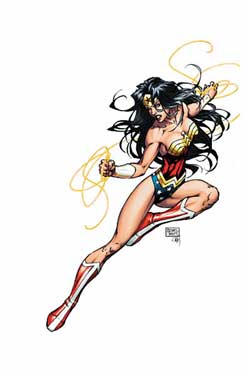Comics /
Comic Reviews /
DC Comics
Justice League of America #7
By Hervé St-Louis
April 12, 2007 - 00:37
Seven, issue (eight, if one count Justice League of America #0), the team decides about its roster and cleans up its past. Rebuilding involves a new headquarter, a new chairwoman, a new character name for Arsenal and many new subplots. This concludes the first Justice League storyline in the latest incarnation of this team.
From the beginning of this story, the emphasis was on the team’s history and past incarnations. Meltzer was particularly interested in what is known as the satellite version of the team, where their headquarters was in space. It was a continuation from the original team, in a modernized fashion and with fewer iconic members. Like an elastic, Meltzer’s version of the Justice League springs back into a mix of old, new and fewer iconic members.
From the beginning of this story, he presented two dualities of what is known as the trinity in DC Comics’ lore. Opposing Wonder Woman, Superman and Batman, figuratively, were Green Lantern, Black Canary and Arsenal, Green Arrow’s former protégée. The first group is continually hailed as the top tier of DC Comics’ caste and a step in complete fantasy land. The second group represented a period in the late 1960s and early 1970s where authority was challenged and where stories became more humanized and relevant for readers.
While the last incarnation of the Justice League, sought the original founders as the backbone of the team and made of them the glorious seven, Meltzer followed the cycle with a reinvigorated Justice League. Out were classic members like the Martian Manhunter, Aquaman and the Flash, in favour of the famous second stringers that were at the core of the satellite Justice League. Among them, Red Tornado and Black Canary.
But Meltzer is not just retreading history, as it once happened, like many writers at DC Comics like to do these days. He combines elements from other DC Comics era which, if followed well by whoever succeeds him as writer, when he ends his tour of duty at issue #12, could make the Justice League an amalgam of the best of the X-Men and the Avengers. The next team that followed the satellite version of the team was the multicoloured team which lived in the midst of humans. Well, here again, Meltzer adds Vixen, another old time League member and Black Lightning, the one character who refused membership.
It’s clear that Meltzer is obsessed with the team he grew up with. References to the Outsiders are plenty and the addition of Red Arrow to the team is seen as the greatest achievement of not mentor Green Arrow, but Black Canary, who saved him from drugs years ago. Although many other writers, like Devin Grayson, have touched upon the ties that the characters have, Meltzer’s interpretation is the shortest, but most effective.
Most of this issue was really boring and just a way to clean up some threads and shows where the team is going next. Meltzer adds some bits for old time fans, like the Hall of Justice. Suddenly, his League gains the credibility it might have lacked by borrowing from the old cartoon series. For newer readers, this issue will be empty of all relevance and interest, as it’s nothing but a treat for old readers who master their comic book history.
Ed Benes continues to not be the man for the job by working on this series. DC Comics is convinced that a popular artist of the month is what it takes to sell this series. But I always wondered why both DC Comics and Marvel Comics relied on artists with poor anatomy but pizzaz to sell their books. A classically trained artist would have been a better choice for this series. A few years from now, when looking at the team's centerfold, it will look dated and a sales drive pitch. The problem is, when half your audience doesn’t like the artist’ work, why do you even bother?
6/10
Last Updated: January 17, 2025 - 08:20
